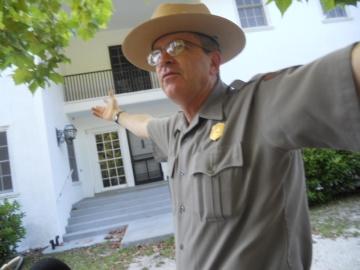
Section Branding
Header Content
Cumberland Island's Wilder Future
Primary Content

Margaret Graves has spent much of her life on Cumberland Island.
The 47-year-old remembers growing up down forested paths that lead to the beach.
"We would load up these old, beat-up cars and drive to the beach. It was always an adventure," Graves says. "Some of the cars, you couldn't always count on them. So, my dad had certain rules about, you had to have a pair of shoes with you."
Graves is a fifth-generation descendent of Andrew Carnegie's brother Thomas, part of the large, extended family that once owned much of the island and gave it to the American people in the 1970's.
As part of the deal that created the National Seashore, the family agreed that Graves could live on the island until last year. She tears up talking about moving day.
"I left sad but also appreciative of the island and its beauty," Graves says.
Residents at six other properties made similar deals.
And in the year since it came time for them all to leave, officials have tried to figure out just what to do with their homes.
Last month, they released their plans and Seashore Superintendent Fred Boyles gave reporters a tour of it.
Boyles unlocks Graves' old home, called The Grange.
"Come on in!" Boyles says.
The Grange is a 7,000 square-foot Georgian-style house surrounded by live oaks and built in 1903.
The foyer wallpaper depicts bright green lily pads.
It's just like the wallpaper in Plum Orchard, a much grander Carnegie home a few miles away that the park service maintains and allows visitors to peek inside.
"It has many of the same kind of building themes," Boyles says. "You see the pocket doors and then the sort of old fashioned fixtures in the bathrooms."
Graves' home is listed as historic for its style and history. Park officials want it to become an education center.
Other newly-public homes are more remote and would be torn down or made off-limits as park staff living quarters.
None of the homes slated for demolition are listed as historic.
Boyles says, it was Congress' original vision for the seashore to become less populated.
"The overriding principle that guides everything is the legislation that created Cumberland Island National Seashore, which clearly states that we should maintain the island in a primitive state," Boyles says.
But Graves and others are critical of the plan.
They point to a National Park Conservation Association report saying the national parks have an $11 billion maintenance backlog.
A National Park Service official says, the backlog is more like $9 billion.
Mark McDonald of the Georgia Trust for Historic Preservation doubts the park service can adequately maintain the homes, especially the historic ones.
"Without the funding, the recommendations are just words on paper and that doesn't keep the roofs on the buildings," McDonald says.
McDonald wants the park service to lease Graves' home so a private resident can live in it and pay its considerable expenses.
Graves, for one, wants to go back.
But Will Harlan of the group Wilderness Watch says, it would set a bad precedent if any of the homes, so-called "retained estates," were allowed to continue in private use.
"It's the most important issue facing the park service today," Harlan says. "None is more important than the proper expiration of these retained estates."
Harlan says, the homes are now the public's and should stay that way.
Boyles, the superintendent, says he'll find the money to keep them up.
Meanwhile, fewer people are living at the Seashore and the public has August twelfth to register comments about the plan to keep it that way.
For the complete National Park Service assessment and recommendations, click here and selected "Former Reserved Properties Management Plan.
The slideshow below shows pictures of the affected properties. It includes audio from Margaret Graves, talking about the history of The Grange and her family on Cumberland Island.
Tags: Cumberland Island, Georgia Trust for Historic Preservation, National Park Service, Cumberland Island National Seashore, GPB News, Wilderness Watch, Will Harlan, Fred Boyles, Margaret Graves, Mark McDonald
